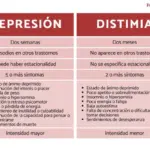He Dysthymic Disorder (dysthymia) is a mild variant of Depression. Dysthymia is usually placed at the edge of the depression spectrum. At the other extreme, more serious, we could place the most acute depressive disorders.
What is Dysthymia?
The word comes from the Greek, “altered mood.” Those affected by dysthymia usually continue with their routine for years without receiving any type of treatment or assistance. They can be recognized by showing signs of depression, but there is nothing in their behavior or attitudes that, a priori, can make us notice that this person really has a psychological disorder. Dysthymia is an affective disorder, and the effectiveness rate of treatments is very high.
Affected people
Dysthymia affects almost 2% of the population, being a little less frequent than major depression (which affects around 4% of people) and, in the same way as other emotional disorders, there is usually a higher rate. of dysthymia among women.
A specific episode of sadness or sadness should not be confused with dysthymic disorder. Every person is susceptible to feeling sad during some life stage, and this does not suggest any abnormality. For the period of melancholy to be considered dysthymia, it must occur every day for at least two years.
Symptoms
The most common symptoms in affected patients are melancholia and the sadness. Generally, they find it almost impossible to find happiness and satisfaction in their daily routine. They also have low self-confidence and are not able to make decisions.
Tiredness and low activity They are also usually signs of dysthymia. Sleep and eating patterns are frequently altered. Regarding rest, those affected by dysthymia may suffer from insomnia, or sleep more hours than recommended. In relation to nutrition, sometimes they have episodes of excessive eating, or a noticeable lack of hunger.
Concentration and memory are affected. It is usual for those affected to begin to isolate themselves socially little by little, a problem that in the long run can lead to social incapacity, and even social phobia.
On the other hand, unlike what happens in some cases of major depression and bipolar disorder, Psychotic symptoms do not appear in dysthymia such as hallucinations or delusions.
Causes
There is some controversy about the causes of dysthymic disorder. Some research points to a prevalence of hereditary factor although new studies suggest that the causes are environmental: social isolation, specific setbacks in life and prolonged stress situations.
The unique peculiarity of dysthymic disorder is that More than 75% of those affected suffer from some other chronic problem such as a physical ailment, drug addiction, or other psychiatric disorder. Medical personnel often have difficulty establishing which problem is earlier, as onset times are frequently dispersed.
Treatment and therapy
The different treatments require intense work with the affected person in order to detect the underlying causes. The two treatment modalities that have been most effective are cognitive-behavioral therapy and psychotherapy.
Furthermore, pharmaceutical supports can significantly help patients affected by dysthymia.
In any case, talking to the patient about their concerns usually helps them a lot, and tends to dispel negative feelings and thoughts such as guilt or the feeling of worthlessness. Psychological treatment also seeks to enable the person to manage their emotions.
In addition to individual therapy, group therapy helps regenerate the affected person’s lost self-esteem and improve social skills.
How is Dysthymia different from Depression?
Those affected by dysthymia usually have a fairly routine and normal life despite their disorder. On the other hand, the depressed patient is not able to maintain that routine. Therefore, the fundamental difference is the degree of incapacitation that the subject presents.









